Family name: Rosaceae Jussieu
Synonym(s): Agrimoniaceae Gray; Alchemillaceae Martinov; Amygdalaceae Marquis, nom. cons.; Cercocarpaceae J. Agardh; Coleogynaceae J. Agardh; Dryadaceae Gray; Fragariaceae Nestl.; Lindleyaceae J. Agardh; Malaceae Small, nom. cons.; Neilliaceae Miq.; Potentillaceae Bercht. & J. Presl; Prunaceae Martinov; Rhodotypaceae J. Agardh; Sanguisorbaceae Bercht. & J. Presl; Spiraeaceae Bertuch; Ulmariaceae Gray
Common name(s): rose family
*Number of genera/species: 111/2,950
List of genera records in GRIN-Global
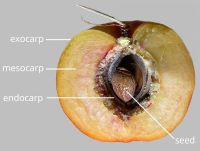 and mesocarpmesocarp:
and mesocarpmesocarp: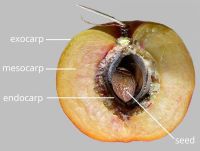 absent and endocarpendocarp:
absent and endocarpendocarp: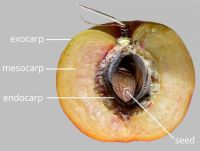 exposed (pyrene), or seed
exposed (pyrene), or seed
Fruit an acheneachene:
a dry, indehiscent, one-seeded fruit, with seed attached to pericarp at a single point, derived from a single, superior, simple or compound, one-loculed ovary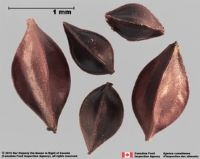 , drupe, or folliclefollicle:
, drupe, or folliclefollicle:
a dry to (rarely) fleshy fruit derived from a single carpel that opens along a single longitudinal suture, derived from a single, superior, simple ovary; the seeds may be arillate or with a fleshy testa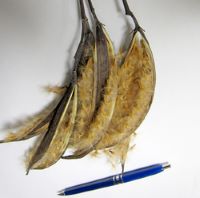 , often aggregated, or pomepome:
, often aggregated, or pomepome:
an indehiscent, fleshy fruit with accessory floral tube tissue adnate to the pericarp, outer wall thick and fleshy, interior contains papery or cartilaginous structures enclosing the seeds, derived from a single, inferior, compound ovary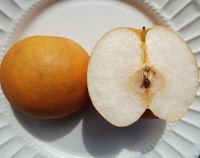 , rarely a capsulecapsule:
, rarely a capsulecapsule:
a dry, dehiscent fruit derived from a compound ovary , 1–150 mm long, globoseglobose:
, 1–150 mm long, globoseglobose:
3D shape—more or less spherical to angledangular:
to angledangular:
2D shape—having sides that meet at acute or obtuse angles
, usually tereteterete:
approximately circular in cross section; width and thickness approximately equal
 in transection, sometimes compressedcompressed:
in transection, sometimes compressedcompressed:
flattened; in grasses, used to denote compression (not necessarily flattened) either laterally or dorsiventrally
(Potentilla, Rhodotypos) or laterally flattened (Holodiscus), stylesstyle:
in a flower, the narrow and elongated part of the pistil between the stigma and the ovary; sometimes persisting in fruit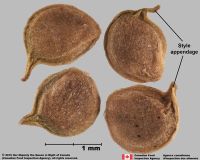 often persistent, forming short or long beaks (long, terminal, hairy stylesstyle:
often persistent, forming short or long beaks (long, terminal, hairy stylesstyle:
in a flower, the narrow and elongated part of the pistil between the stigma and the ovary; sometimes persisting in fruit in Dryas and Geum). Fruits sometimes winged (Amygdaloideae), if winged, wings at both ends or only a apexapex:
in Dryas and Geum). Fruits sometimes winged (Amygdaloideae), if winged, wings at both ends or only a apexapex:
the point farthest from the point of attachment, or the "tip" of an organ or may appear caudatecaudate:
or may appear caudatecaudate:
tapering to a long, tail-like appendage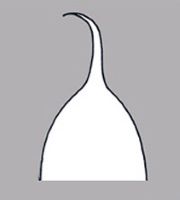 at both ends. Fruits with one seed achenesachene:
at both ends. Fruits with one seed achenesachene:
a dry, indehiscent, one-seeded fruit, with seed attached to pericarp at a single point, derived from a single, superior, simple or compound, one-loculed ovary , drupeletsdrupelet:
, drupeletsdrupelet:
one drupe of a fruit with multiple drupes, as in blackberries
) or with few to less than 20 seeds (sometimes many-seeded in pomespome:
an indehiscent, fleshy fruit with accessory floral tube tissue adnate to the pericarp, outer wall thick and fleshy, interior contains papery or cartilaginous structures enclosing the seeds, derived from a single, inferior, compound ovary ), often enclosed by hypanthium and crowned by persistent calyxcalyx:
), often enclosed by hypanthium and crowned by persistent calyxcalyx:
the outer whorl of the perianth; all the sepals of a flower , or subtended by persistent calyxcalyx:
, or subtended by persistent calyxcalyx:
the outer whorl of the perianth; all the sepals of a flower . Hypanthium, if present, fused to fruit wall, fleshy, and cupular or narrow-mouthed. Rarely fruits attached to enlarged, fleshy or not fleshy torus. Pericarppericarp:
. Hypanthium, if present, fused to fruit wall, fleshy, and cupular or narrow-mouthed. Rarely fruits attached to enlarged, fleshy or not fleshy torus. Pericarppericarp:
fruit wall or fruit coat
black, blue or purplish black, purple, brown, green, red, orange, or yellow, rarely white (Osteomeles), shinyshiny:
uniformly reflecting a high proportion of incident light at all angles or dulldull:
or dulldull:
reflecting only a low proportion of incident light, with no apparent sheen , thick- or thin-walled, bonybony:
, thick- or thin-walled, bonybony:
very hard and rather brittle, like bone
, cartilaginouscartilaginous:
texture—firm, dense, tough, somewhat pliable, and resilient, like cartilage
, leatheryleathery:
texture—moderately thick, tough, and very pliable
, fibrousfibrous:
texture -- long, flexible threads, thicker than hairs, that densely cover and obscure the surface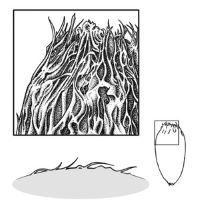 , woodywoody:
, woodywoody:
texture—consisting mainly of indurate lignified tissues, characteristic of or resembling wood
, or fleshy, sometimes gritty, glabrousglabrous:
without hairs
or pubescentpubescent:
surface relief—bearing hairs
. If pubescentpubescent:
surface relief—bearing hairs
often densely so with short, white hairs, rarely with long-stalked glands (Neillia spp.). Pericarppericarp:
fruit wall or fruit coat
(or hypanthium) smooth or ridgedridged:
surface relief—raised, thick ridges, sharp edged or rounded, usually in a series that may cover the entire surface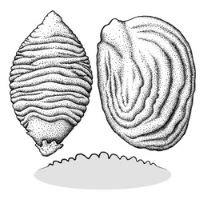 , ribbedribbed:
, ribbedribbed:
surface relief—wide, prominent, linear ridges that are generally rounded and longitudinally situated on the surface , wrinkledwrinkled:
, wrinkledwrinkled:
surface relief—shallow, irregular folds and furrows covering the surface; appearing overall though crumpled and then spread out , punctatepunctate:
, punctatepunctate:
surface relief—dotted with pits or with translucent, sunken glands or with colored dots, similar to pitted , or with bristles, spines, or protuberances. In pomespome:
, or with bristles, spines, or protuberances. In pomespome:
an indehiscent, fleshy fruit with accessory floral tube tissue adnate to the pericarp, outer wall thick and fleshy, interior contains papery or cartilaginous structures enclosing the seeds, derived from a single, inferior, compound ovary , the fleshy layer is derived from hypanthial and/or carpellary tissue and may have sclereids (gritty) or not and have large pigment cells or not. A pome’s endocarpendocarp:
, the fleshy layer is derived from hypanthial and/or carpellary tissue and may have sclereids (gritty) or not and have large pigment cells or not. A pome’s endocarpendocarp:
the inner layer of the pericarp, if divided into layers may be firm-membranous, cartilaginouscartilaginous:
may be firm-membranous, cartilaginouscartilaginous:
texture—firm, dense, tough, somewhat pliable, and resilient, like cartilage
, leatheryleathery:
texture—moderately thick, tough, and very pliable
, bonybony:
very hard and rather brittle, like bone
or slightly woodywoody:
texture—consisting mainly of indurate lignified tissues, characteristic of or resembling wood
.
Fruit type by subfamily
Amygdaloideae: acheneachene:
a dry, indehiscent, one-seeded fruit, with seed attached to pericarp at a single point, derived from a single, superior, simple or compound, one-loculed ovary , nutletnutlet:
, nutletnutlet:
˜achene
, or folliclefollicle:
a dry to (rarely) fleshy fruit derived from a single carpel that opens along a single longitudinal suture, derived from a single, superior, simple ovary; the seeds may be arillate or with a fleshy testa , often aggregated, or pomepome:
, often aggregated, or pomepome:
an indehiscent, fleshy fruit with accessory floral tube tissue adnate to the pericarp, outer wall thick and fleshy, interior contains papery or cartilaginous structures enclosing the seeds, derived from a single, inferior, compound ovary , drupedrupe:
, drupedrupe:
(indehiscent drupe) a fleshy, indehiscent fruit with one more hard pits enclosing seeds, derived from single, superior, simple or compound ovary; (dehiscent drupe) a fruit with a dry or fibrous to fleshy or leathery outer husk that early to tardily breaks apart (or opens), exposing one or more nutlike pits enclosing the seeds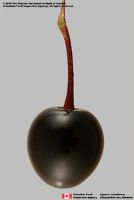 , or capsulecapsule:
, or capsulecapsule:
a dry, dehiscent fruit derived from a compound ovary
Dryadoideae: acheneachene:
a dry, indehiscent, one-seeded fruit, with seed attached to pericarp at a single point, derived from a single, superior, simple or compound, one-loculed ovary or head of achenesachene:
or head of achenesachene:
a dry, indehiscent, one-seeded fruit, with seed attached to pericarp at a single point, derived from a single, superior, simple or compound, one-loculed ovary (with long persistent, terminal, hairy stylesstyle:
(with long persistent, terminal, hairy stylesstyle:
in a flower, the narrow and elongated part of the pistil between the stigma and the ovary; sometimes persisting in fruit , Dryas)
, Dryas)
Rosoideae: acheneachene:
a dry, indehiscent, one-seeded fruit, with seed attached to pericarp at a single point, derived from a single, superior, simple or compound, one-loculed ovary , 1 or 2 or numerous (Rosa) enclosed in hypanthium (with bristles Agrimonia, with spines Acaena, red and fleshy Aremonia, Sarcopoterium). Or follicle-like acheneachene:
, 1 or 2 or numerous (Rosa) enclosed in hypanthium (with bristles Agrimonia, with spines Acaena, red and fleshy Aremonia, Sarcopoterium). Or follicle-like acheneachene:
a dry, indehiscent, one-seeded fruit, with seed attached to pericarp at a single point, derived from a single, superior, simple or compound, one-loculed ovary (Filipendula, indehiscentindehiscent:
(Filipendula, indehiscentindehiscent:
not opening on its own, as in a fruit
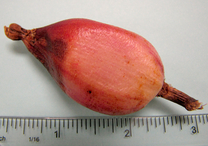 ), head of achenesachene:
), head of achenesachene:
a dry, indehiscent, one-seeded fruit, with seed attached to pericarp at a single point, derived from a single, superior, simple or compound, one-loculed ovary (with long persistent, terminal, hairy stylesstyle:
(with long persistent, terminal, hairy stylesstyle:
in a flower, the narrow and elongated part of the pistil between the stigma and the ovary; sometimes persisting in fruit , Geum), or aggregated nutletsnutlet:
, Geum), or aggregated nutletsnutlet:
˜achene
(Leucosidea) or drupeletsdrupelet:
one drupe of a fruit with multiple drupes, as in blackberries
(Rubus)
Seeds globoseglobose:
3D shape—more or less spherical to pyriform, rarely reniformreniform:
to pyriform, rarely reniformreniform:
2D or 3D shape—kidney-shaped (Potentilla), sometimes with fold between cotyledons and hypocotyl-radicle or notched, 1.5–5 mm long. RaphaeRaphe:
(Potentilla), sometimes with fold between cotyledons and hypocotyl-radicle or notched, 1.5–5 mm long. RaphaeRaphe:
a ridge or seam on the seed coat, formed by the portion of the funiculus united to the ovule wall in longitudinally curved ovules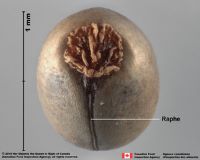 sometimes conspicuous. ArilsAril:
sometimes conspicuous. ArilsAril:
(broad sense) appendicular structure that wholly or partly envelops a seed and is produced from or a modification of the funicle, raphe, or outer integument; usually fleshy or pulpy, sometimes spongy or tufted-capillate, often brightly colored or aril-like structure usually absent, except for carunclescaruncle:
or aril-like structure usually absent, except for carunclescaruncle:
a localized outgrowth of the seed coat near the hilum of the seed; it functions as an elaiosome on Physocarpus seeds. Seed coat black or brown, glabrousglabrous:
on Physocarpus seeds. Seed coat black or brown, glabrousglabrous:
without hairs
, usually thin, firm, membranousmembranous:
texture—extremely thin, pliable, and fairly tough
, or leatheryleathery:
texture—moderately thick, tough, and very pliable
, smooth or ridgedridged:
surface relief—raised, thick ridges, sharp edged or rounded, usually in a series that may cover the entire surface , striatestriate:
, striatestriate:
surface relief—having fine, parallel lines, grooves or ridges , pittedpitted:
, pittedpitted:
surface relief—surface with small depressions in which the areas between the hollows do not take on the appearance of a true reticular net , papillatepapillate:
, papillatepapillate:
surface relief—bearing minute, distinct, broad-based projections, tapering to a rounded apex , punctatepunctate:
, punctatepunctate:
surface relief—dotted with pits or with translucent, sunken glands or with colored dots, similar to pitted , or wrinkledwrinkled:
, or wrinkledwrinkled:
surface relief—shallow, irregular folds and furrows covering the surface; appearing overall though crumpled and then spread out . Margins with markedly different tissue than rest of seed coat.
. Margins with markedly different tissue than rest of seed coat.
Embryo well developed, completely to nearly completely filling seed coat, axileaxile:
on or of the axis
and centric, foliatefoliate:
appearing leaf-like
or linearlinear:
(shape) long, narrow, and uniform in width; (of embryo) embryo is straight and much longer than wide , straight, bentbent:
, straight, bentbent:
(of embryo) embryo is bent at an acute, V-shaped angle with the ends close together and generally thick cotyledons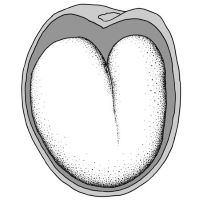 , or curvedcurved:
, or curvedcurved:
(of embryo) linear embryo is curved into an arch or horseshoe with the ends far apart . Cotyledons thin, flat or once-folded, rarely convolute, with entire apicesapex:
. Cotyledons thin, flat or once-folded, rarely convolute, with entire apicesapex:
the point farthest from the point of attachment, or the "tip" of an organ .
.
Endosperm usually thin, sometimes absent, rarely copious (Kerria, Neillia, Physocarpus), if present fleshy and smooth. Perispermperisperm:
seed nutritive tissue comparable to the endosperm, but derived from the nucellus (maternal tissue)
present.
Noxious Weeds: USA Federal Noxious Weed List, terrestrial, Rubus fruticosus L. (complex), Rubus moluccanus L.
Federal Noxious Weed Disseminules of the US tool provides descriptions and images of these species.
| Fruit | |
| Type | acheneachene: a dry, indehiscent, one-seeded fruit, with seed attached to pericarp at a single point, derived from a single, superior, simple or compound, one-loculed ovary  , folliclefollicle: , folliclefollicle:a dry to (rarely) fleshy fruit derived from a single carpel that opens along a single longitudinal suture, derived from a single, superior, simple ovary; the seeds may be arillate or with a fleshy testa  , drupedrupe: , drupedrupe:(indehiscent drupe) a fleshy, indehiscent fruit with one more hard pits enclosing seeds, derived from single, superior, simple or compound ovary; (dehiscent drupe) a fruit with a dry or fibrous to fleshy or leathery outer husk that early to tardily breaks apart (or opens), exposing one or more nutlike pits enclosing the seeds  , pomepome: , pomepome:an indehiscent, fleshy fruit with accessory floral tube tissue adnate to the pericarp, outer wall thick and fleshy, interior contains papery or cartilaginous structures enclosing the seeds, derived from a single, inferior, compound ovary  , rarely capsulecapsule: , rarely capsulecapsule:a dry, dehiscent fruit derived from a compound ovary  |
| Size range | 1–150 mm long |
| Shape(s) | globoseglobose: 3D shape—more or less spherical  , cymbiformcymbiform: , cymbiformcymbiform:3D shape - boat-shaped, navicular , ellipsoidellipsoid: 3D shape—elliptic , oblongoblong: 2D shape—much longer than broad with nearly parallel sides, corners are rounded  , ovoidovoid: , ovoidovoid:3D shape—ovate  , conicalconical: , conicalconical:3D shape—cone-shaped, with the point of attachment at the broad end 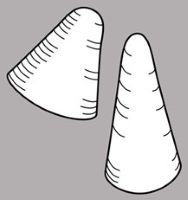 , pear-shaped, boat-shaped, lanceoloidlanceoloid: , pear-shaped, boat-shaped, lanceoloidlanceoloid:3D shape—lanceolate , falcatefalcate: shaped like a scythe or sickle  , reniformreniform: , reniformreniform:2D or 3D shape—kidney-shaped  , 4- angledangular: , 4- angledangular:2D shape—having sides that meet at acute or obtuse angles |
| Texture | thick or thin walled, bonybony: very hard and rather brittle, like bone , cartilaginouscartilaginous: texture—firm, dense, tough, somewhat pliable, and resilient, like cartilage , leatheryleathery: texture—moderately thick, tough, and very pliable , fibrousfibrous: texture -- long, flexible threads, thicker than hairs, that densely cover and obscure the surface  , woodywoody: , woodywoody:texture—consisting mainly of indurate lignified tissues, characteristic of or resembling wood , fleshy, sometimes gritty |
| Surface relief | smooth, ridgedridged: surface relief—raised, thick ridges, sharp edged or rounded, usually in a series that may cover the entire surface  , ribbedribbed: , ribbedribbed:surface relief—wide, prominent, linear ridges that are generally rounded and longitudinally situated on the surface  , wrinkledwrinkled: , wrinkledwrinkled:surface relief—shallow, irregular folds and furrows covering the surface; appearing overall though crumpled and then spread out  , punctatepunctate: , punctatepunctate:surface relief—dotted with pits or with translucent, sunken glands or with colored dots, similar to pitted  , with bristles, spines, or protuberances , with bristles, spines, or protuberances |
| Color(s) | black, blue or purplish black, purple, brown, green, red, orange, yellow, rarely white |
| Unique features | Five types of fruits. 1) Small achenesachene: a dry, indehiscent, one-seeded fruit, with seed attached to pericarp at a single point, derived from a single, superior, simple or compound, one-loculed ovary  aggregated or not, with persistent stylesstyle: aggregated or not, with persistent stylesstyle:in a flower, the narrow and elongated part of the pistil between the stigma and the ovary; sometimes persisting in fruit  , which are often hooked and/or hairy. Infrequently achenesachene: , which are often hooked and/or hairy. Infrequently achenesachene:a dry, indehiscent, one-seeded fruit, with seed attached to pericarp at a single point, derived from a single, superior, simple or compound, one-loculed ovary  attached to fleshy central tissue. 2) Aggregateaggregate: attached to fleshy central tissue. 2) Aggregateaggregate:fruit formed from a single flower with carpels several and distinct  of drupesdrupe: of drupesdrupe:(indehiscent drupe) a fleshy, indehiscent fruit with one more hard pits enclosing seeds, derived from single, superior, simple or compound ovary; (dehiscent drupe) a fruit with a dry or fibrous to fleshy or leathery outer husk that early to tardily breaks apart (or opens), exposing one or more nutlike pits enclosing the seeds  . 3) AchenesAchene: . 3) AchenesAchene:a dry, indehiscent, one-seeded fruit, with seed attached to pericarp at a single point, derived from a single, superior, simple or compound, one-loculed ovary  surrounded by green tissue. 4) Flesh fruit with stone surrounding seeds. 5) Fruit with grainy fleshy pulp surrounding seeds. surrounded by green tissue. 4) Flesh fruit with stone surrounding seeds. 5) Fruit with grainy fleshy pulp surrounding seeds. |
| Seed | |
| Size range | 1.5–5 mm long |
| Shape(s) | globoseglobose: 3D shape—more or less spherical  , ellipsoidellipsoid: , ellipsoidellipsoid:3D shape—elliptic , linearlinear: (shape) long, narrow, and uniform in width; (of embryo) embryo is straight and much longer than wide  , fusiformfusiform: , fusiformfusiform:spindle-shaped; broadest at the middle and tapering at both ends 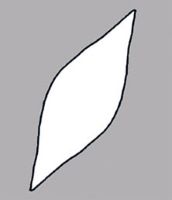 , oblongoblong: , oblongoblong:2D shape—much longer than broad with nearly parallel sides, corners are rounded  , ovoidovoid: , ovoidovoid:3D shape—ovate  , lanceoloidlanceoloid: , lanceoloidlanceoloid:3D shape—lanceolate , pear-shaped, rarely reniformreniform: 2D or 3D shape—kidney-shaped  |
| Surface relief | smooth, ridgedridged: surface relief—raised, thick ridges, sharp edged or rounded, usually in a series that may cover the entire surface  , striatestriate: , striatestriate:surface relief—having fine, parallel lines, grooves or ridges  , pittedpitted: , pittedpitted:surface relief—surface with small depressions in which the areas between the hollows do not take on the appearance of a true reticular net  papillatepapillate: papillatepapillate:surface relief—bearing minute, distinct, broad-based projections, tapering to a rounded apex  , punctatepunctate: , punctatepunctate:surface relief—dotted with pits or with translucent, sunken glands or with colored dots, similar to pitted  , wrinkledwrinkled: , wrinkledwrinkled:surface relief—shallow, irregular folds and furrows covering the surface; appearing overall though crumpled and then spread out  |
| Color(s) | black, brown |
| Other | |
| Embryo | well developed, completely to nearly completely filling seed coat, axileaxile: on or of the axis and centric, foliatefoliate: appearing leaf-like or linearlinear: (shape) long, narrow, and uniform in width; (of embryo) embryo is straight and much longer than wide  , straight, bentbent: , straight, bentbent:(of embryo) embryo is bent at an acute, V-shaped angle with the ends close together and generally thick cotyledons  , or curvedcurved: , or curvedcurved:(of embryo) linear embryo is curved into an arch or horseshoe with the ends far apart  . Cotyledons thin, flat or once-folded, rarely convolute, with entire apicesapex: . Cotyledons thin, flat or once-folded, rarely convolute, with entire apicesapex:the point farthest from the point of attachment, or the "tip" of an organ  . . |
| Nutritive tissue | endosperm usually thin, sometimes absent, rarely copious (Kerria, Neillia, Physocarpus), if present fleshy and smooth. Perispermperisperm: seed nutritive tissue comparable to the endosperm, but derived from the nucellus (maternal tissue) present. |
Nearly worldwide, diverse in subtropics and temperate regions of the Northern Hemisphere.
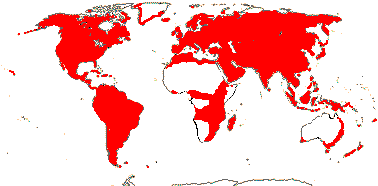
Distribution map courtesy of Angiosperm Phylogeny Website.
Hyde et al. 2021c+Hyde et al. 2021c+:
Hyde MA, Wursten BT, Ballings P, and Coates Palgrave M. 2021c+. Flora of Zimbabwe. Accessed January 2021–April 2024. URL: https://www.zimbabweflora.co.zw/index.php; Flora of North America Editorial Committee 1993+Flora of North America Editorial Committee 1993+:
Flora of North America Editorial Committee, eds. 1993+. Flora of North America North of Mexico [Online]. 22+ vols. Flora of North America Association, New York and Oxford. Accessed January-March 2024. URL: http://beta.floranorthamerica.org.; Kirkbride et al. 2006Kirkbride et al. 2006:
Kirkbride JH, Jr, Gunn CR, and Dallwitz MJ. 2006. Family guide for fruits and seeds, vers. 1.0. Accessed September 2020-January 2022. URL: https://nt.ars-grin.gov/seedsfruits/keys/frsdfam/index.cfm .; Kubitzki et al. 1990+Kubitzki et al. 1990+:
Kubitzki K et al., eds. 1990+. The families and genera of vascular plants. 7+ vols. Berlin etc.; Liu et al. 2019Liu et al. 2019:
Liu B-B, Hong D-Y, Zhou S-L, Xu C, Dong W-P, Johnson G, and Wen J. 2019. Phylogenomic analyses of the Photinia complex support the recognition of a new genus Phippsiomeles and the resurrection of a redefined Stranvaesia in Maleae (Rosaceae). Journal of Systematics and Evolution 57: 678–694. https://doi.org/10.1111/jse.12542; Nooteboom et al. 2021+Nooteboom et al. 2021+:
Nooteboom HP, de Wilde WJJO, Stevens PF, Coode MJE, and Saw LG. 2021+ Flora Malesiana Online. Accessed January 2021–March 2024. URL: https://portal.cybertaxonomy.org/flora-malesiana/; Noxious Weed Regulations 2020Noxious Weed Regulations 2020:
Noxious Weed Regulations. 2020. 7 C.F.R. sect; 360.100-360.600.; Phipps 1992Phipps 1992:
Phipps HB. 1992. Heteromeles and Photinia (Rosaceae, subfam. Maloideae) of Mexico and Central America. Canadian Journal of Botany. 70(11): 2138&-2162.; Takhtajan 2009Takhtajan 2009:
Takhtajan A. 2009. Flowering plants: Second edition. Springer Nature, Switzerland. 871 pp.; Tutin et al. 1968Tutin et al. 1968:
Tutin TG, Heywood VH, Burges NA, Moore DM, Valentine DH, Walters SM, and Webb DA, eds. 1968. Flora Europaea. Vol V: Rosaceae to Umbelliferae. Cambridge University Press, Cambridge UK. 455 pp.; USDA 1980USDA 1980:
United States Dept. of Agriculture (USDA). 1980. Major weed family identification guide. Hyattsville Md, United States
*The number of genera and species is based on Christenhusz and Byng 2016Christenhusz and Byng 2016:
Christenhusz MJM and Byng JW. 2016. The number of known plant species in the world and its annual increase. Phytotaxa 261 (3): 201-217. https://doi.org/10.11646/phytotaxa.261.3.1, which may differ from the number of genera in GRIN-Global.